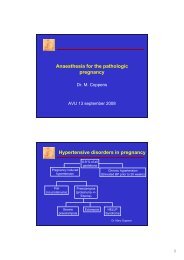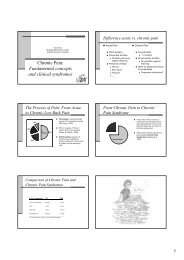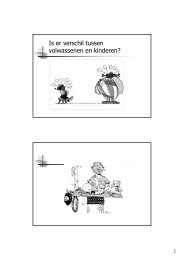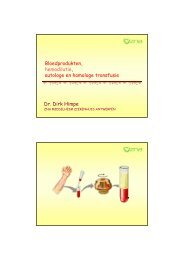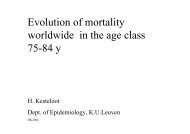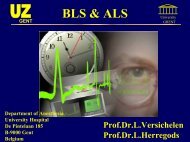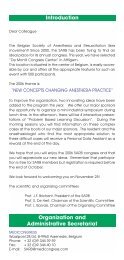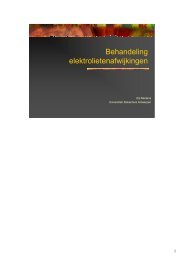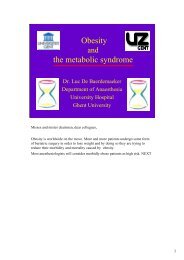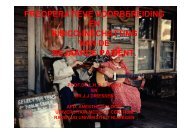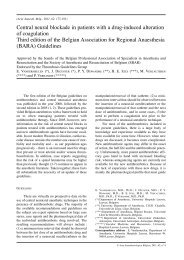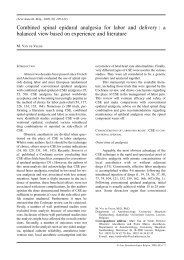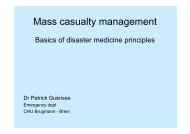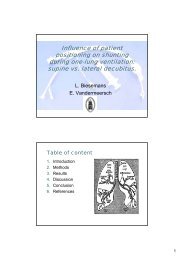Postoperatieve complicaties, exclusief respiratoire
Postoperatieve complicaties, exclusief respiratoire
Postoperatieve complicaties, exclusief respiratoire
Create successful ePaper yourself
Turn your PDF publications into a flip-book with our unique Google optimized e-Paper software.
Post-Operatieve Complicaties<br />
(<strong>exclusief</strong> <strong>respiratoire</strong>)<br />
Dr. Caroline Vanlersberghe<br />
Dienst Anesthesiologie<br />
UZ-Brussel<br />
Vrije Universiteit Brussel<br />
Ontwaken uit Anesthesie<br />
Luchtwegobstructie<br />
g<br />
Rillen<br />
Nausea en braken<br />
Agitatie, confusie of delirium<br />
Pijn<br />
Hypothermie<br />
Labiliteit autonoom zenuwstelsel<br />
1
Factoren die Impact hadden op<br />
PostAnesthesie Zorgen<br />
Creatie van specifieke zone voor observatie en<br />
behandeling van patient na anesthesie/heelkunde<br />
Ontwikkeling gespecialiseerde nursing voor<br />
onderkennen van specifieke <strong>complicaties</strong> tijdens de<br />
onmiddellijke postoperatieve periode<br />
Identificatie en beschikbaarheid van anesthesioloog<br />
voor medisch beleid PACU<br />
Standaardnormen en -procedures voor PACU<br />
Speciale zorgeenheden voor specifieke populaties<br />
(low/high/pediatric care/extended observation unit)<br />
Taak van de PACU<br />
Medische supervisie en coördinatie patiëntenzorg<br />
Observatie en bewaking van vitale functies en<br />
psychische toestand van de geopereerde patiënt<br />
Specifieke bewakingstechnieken (hart- en<br />
longfuncties)<br />
Bijstand en sturing van oxygenatie, ventilatie,<br />
circulatie en lichaamstemperatuur<br />
Diagnose en accurate behandeling van<br />
postoperatieve <strong>complicaties</strong><br />
2
Procedure voor PACU-Opname<br />
Onstabiele fysiologie bij ontwaken vereist<br />
maximum veiligheid<br />
• controleplicht bij installatie patiënt<br />
Nut PACU Admission Report<br />
Noodzaak adequaat postoperatief<br />
behandelingsplan en informatie over potentiële<br />
klinische <strong>complicaties</strong><br />
Delegatie verantwoordelijkheid id naar PACU-VP:<br />
pas wanneer hemodynamische, ventilatoire en<br />
luchtwegenstatus stabiel<br />
PACU Admission Report<br />
Preoperatieve anamnese<br />
• allergie/allergische reacties<br />
• medische pathologie<br />
• laatste chronische medicatie<br />
• acute problemen (ischemie,<br />
deshydratatie, zuur-base)<br />
Intraoperatieve factoren<br />
• heelkunde, type anesthesie<br />
• spierrelaxantia/antagonisten<br />
• onverwachte heelk./anesth.<br />
Gebeurtenissen<br />
• vitale tekens, labo’s,<br />
urinedebiet,bloedverlies<br />
• perfusies, medicaties<br />
• opioiden (tijd, dosis)<br />
Evaluatie huidige status<br />
• HR, BD, T°, ventilatie<br />
• bewustzijnsniveau<br />
• positie ET-tube<br />
• monitoring, catheters (epidurale,<br />
invasieve)<br />
• Algemene indruk<br />
<strong>Postoperatieve</strong> instructies<br />
• geanticipeerde problemen<br />
(hemodynamisch, ventilatoir, labotesten,<br />
RX, urinedebiet)<br />
• aanvaardbaar bloedverlies<br />
li<br />
• therapeutische orders, positie<br />
• therapeutische eindpunten vóór<br />
ontslag<br />
3
Probleemstelling PACU<br />
Hoge doorstroming van patiënten in beperkte<br />
ruimte<br />
Mix van patiënten met verschillende<br />
conditionerings- en stabilisatieproblemen<br />
Verwikkelingen anecdotisch gerapporteerd<br />
• Hemodynamische incidenten : meest frequent<br />
• Respiratoire <strong>complicaties</strong> : meest significante morbiditeit<br />
PACU Situaties met Morbiditeit<br />
Respiratoir<br />
• hypoventilatie, luchtwegobstructie<br />
Hemodynamisch<br />
• aritmie, bloeddrukwijzigingen, ischemie<br />
Nausea en braken<br />
Hypothermie<br />
Ontwaakdelirium<br />
Pijn<br />
4
<strong>Postoperatieve</strong> Pijn<br />
Patiënt gebonden factoren<br />
• Leeftijd<br />
• Preoperatieve persoonlijkheid<br />
• Psychologische voorbereiding<br />
Anesthetische factoren<br />
• Preoperatieve medicatie<br />
• Gebruikte anesthetica en techniek<br />
Heelkundige factoren<br />
• Lokalisatie<br />
• Uitgebreidheid<br />
• <strong>Postoperatieve</strong> <strong>complicaties</strong><br />
Respiratoire Bewaking<br />
Luchtweg obstructie :<br />
• farmaca : sedatie, spierhypotonie, areflexie<br />
• weerslag : hypoventilatie, mucusevacuatie, bronchospasme,<br />
atelectase, aspiratie, acuut longoedeem<br />
Residuele curarisatie / anesthetica :<br />
• laryngeale incompetentie, V/Q stoornissen, depressie<br />
hypoxische regulatie ademhaling<br />
Laryngospasme, aspiratie en pneumothorax<br />
Type heelkunde: hoofd, hals, thorax, abdomen,<br />
wervelzuil (atelectasen)<br />
Pijn : narcotica, CZS depressie<br />
5
Pulsoximetrie<br />
Transport naar PACU<br />
• 35% patienten t S p O 2 < 90% (P a O 2 60 mmHg)<br />
• 12% patienten S p O 2 < 85% (P a O 2 50 mmHg)<br />
• Kinderen : cyanose aanwezig in < 50% met desaturatie<br />
• O 2 toediening tijdens transport<br />
Continue bewaking S p O 2<br />
Ontslag uit PACU : geen relatie PAR scores<br />
en oxygenatie<br />
• voor ontslag : S p O 2 92-96% met lucht 10-15 min<br />
• zo negatief : transport naar zaal met O 2<br />
Hemodynamische Instabiliteit<br />
Training : BD, CVD, PAD<br />
Risicofactoren :<br />
• hypertensie, cardiovasculaire pathologie<br />
• ASA, ouderdom,<br />
• type en duur alsook dringendheid heelkunde<br />
• <strong>respiratoire</strong> dysfunctie, agitatie en pijn<br />
Nut van grenswaarden?<br />
6
Cardiovasculaire Problemen<br />
Hypotensie<br />
Hypertensie<br />
• hypovolemie<br />
• Excitatie bij ontwaken<br />
• hypoxie<br />
• pijn<br />
• afname autonome<br />
tonus<br />
•<br />
•<br />
hypoxie, hypercarbie<br />
blaasdistentie<br />
• overdosering<br />
• perifere<br />
medicatie<br />
vasoconstrictie<br />
• low output failure • intracraniele i heelkunde<br />
• majeure vasculaire<br />
heelkunde<br />
Therapie: O 2 + behandel oorzaak<br />
Hypotensie<br />
‣ Absolute hypovolemie (reductie circulerend intravasculair volume)<br />
→↓ ventriculaire vulling en CO<br />
→ SZS-gemedieerde tachycardie, ↑ SVR en venoconstrictie kunnen<br />
compenseren voor 15-20% verlies intravasculair volume.<br />
Oorzaak: preoperatief vochtdeficiet, per-en postoperatief bloed en<br />
vochtverlies (bloeding, zweten, exsudatie (3de ruimte)<br />
Cavé: in hypotherme, venogeconstrikteerde patiënt kan laag<br />
intravasculair volume CO behouden doch hypotensie veroorzaken als<br />
veneuze capaciteit toeneemt door opwarmen.<br />
Relatieve hypovolemie (normaal intravasculair volume)<br />
‣ Plotse ↓ SZS activiteit door pijnbestrijding of vasovagale respons →↑<br />
veneuze capaciteit<br />
‣ Medicatie α-adrenerge g blockade (droperidol), histamine release<br />
(morfine) of directe veneuze dilatatie ( furosemide, nitraten)<br />
‣ Spinale of epidurale anesthesie (interferentie SZS)<br />
‣ Compressie thoracale venen tgv PPV<br />
‣ Compressie v cava inferior: zwangerschap, ↑ intra-abdominale druk<br />
Mechanisch<br />
‣ Pericard tamponade, pneumothorax<br />
P. Barash<br />
7
Hypotensie<br />
Ventriculaire dysfunctie<br />
• Excessieve vocht administratie → dilatatie ventrikel,<br />
↓ CO en hypotensie, vaak x hydrostatisch<br />
longoedeem<br />
• Sympathisch blok gedurende epidurale of spinale<br />
anesthesie behandeld met excessieve<br />
vochttoediening<br />
→ ventriculaire vullingsdrukken normaal tijdens<br />
ondanks hypervolemie<br />
→ Na opklaren blok: SZS outflow mobiliseert grote<br />
vochtvolumes naar centrale circulatie → ventriculair<br />
falen<br />
P. Barash<br />
Hypotensie<br />
‣ Myocardiale ischemie<br />
‣ Cardiale dysrhytmia<br />
‣ Sinus of nodale bradycardie (
<strong>Postoperatieve</strong> Hypertensie & Tachycardie<br />
↑ Sympatische activiteit<br />
• Schadelijke stimuli:<br />
• Pijn, angst, craniële stimulatie, volle blaas, ET<br />
• Nadelige fysiologische condities:<br />
• Hypercarbia/acidosis, hypoxemia, hypotensie,hypolycemie,<br />
congestief hartfalen, ↑ intracraniële druk,myocard ischemie<br />
• Medicatie:<br />
• β-mimetische pressoren, ephedrine, isoproterenol, epinephrine<br />
• Dopamine, dobutamine<br />
• Bronchodilators, terbutaline,aminophylline<br />
• Antihypertensiva: hydralazine, nitroprusside<br />
• Anesthetics:<br />
• Ketamine, isoflurane<br />
↓ Parasympatische activiteit<br />
• Medicaties:<br />
• Parasympatholytica: atropine, glycopyrrolaat<br />
• Spierrelaxantia: pancuronium<br />
P. Barash<br />
<strong>Postoperatieve</strong> Hypertensie:<br />
therapeutische benadering<br />
Intraveneuze VD<br />
• Nitroglycerine : vrijkomen NO → arteriële VD en venodilatatie → draagt bij tot<br />
labiele hemodynamische staat<br />
Calcium channel blokkers<br />
• Verapamil, diltiazem, dihydropyridine (DHP) nicardipine<br />
• ↓ Ca entry in vasculair glad spierweefsel →VD<br />
• DHP → vnl VD perifere weerstands arteries; in dosis effectief om BD ↓ , weinig<br />
of geen direct effect op cardiale contractiliteit of conductie. Gebrek aan negatief<br />
chronotroop effect → initiële reflex ↑ HR die ↓ gedurende langdurige therapie<br />
• Geen effect op veneus glad spierweefsel → geen venodilatatie en weinig effect<br />
op vullingsdruk en preload → CO = of ↑<br />
• Nicardipine potent coronair en cerebraal VD (neurochirurgie en cardiochirurgie)<br />
ACE‐inhibitors : hartfalen<br />
β‐adrenerge blokkers:<br />
• ↓HR en myocardiale contractiliteit, ↓CO →↓ DBP & SBP<br />
• Vnl in geval tachycardia eerste lijnstherapie: propranolol, metoprolol, esmolol<br />
• Voordeel esmolol : kort eliminatie half‐leven (
Cardiovasculaire Problemen<br />
Tachycardie<br />
• Pijn, angst<br />
• orthosymp. stimulatie<br />
• hypovolemie<br />
• hypotensie<br />
• hypoxemie<br />
• koorts<br />
• endotoxine shock<br />
• farmaca<br />
Bradycardie<br />
• Excessieve<br />
parasympathische tonus<br />
• spinale / epidurale<br />
• hypothermie<br />
• toename ICP<br />
• atleet<br />
• residueel effect van<br />
neostigmine, β-blokker<br />
Bradycardie<br />
↑ Parasympatische activiteit<br />
• Vagale reflexen:<br />
• Carotis sinus massage, valsalva maneuver, kokhalzen, rectaal<br />
onderzoek, ↑ oculaire druk, blaas distentie, faryngeale stimulatie<br />
• Parasympathomimetische medicatie:<br />
• Acetylcholinesterase inhibitor: neostigmine, edrophonium<br />
• Alfa-adrenerge farmaca: neosynephrine, norepinephrine<br />
• Opioiden: morphine, fentanyl, sufentanil, alfentanil, remifentanil<br />
• Succinylcholine<br />
↓ Sympatische activiteit<br />
• Hoge spinale of epidurale anesthesie<br />
• Wegnemen van stimulus, extubatie, blaaslediging<br />
• Zware acidemie/hypoxemie<br />
• Sympatholytische medicatie:<br />
• Beta-receptor blokkers (propranolol)<br />
• Opioiden/sedativa/algehele anesthesie<br />
• Ganglion blokkers<br />
• Lokale anesthetica<br />
P. Barash<br />
10
Hemodynamische Instabiliteit<br />
Teken<br />
Definitie<br />
Hypertensie ↑ met 20% tov preoperatieve baseline waarde gedurende 15<br />
min of SBP > 180mmHg of DBP > 110 mmHg<br />
Hypotensie ↓ met 20% tov preoperatieve baseline waarde gedurende 15<br />
min of SBP < 80 mmHg of DBP < 50 mmHG<br />
Tachycardia ↑ met 20% tov preoperatieve baseline waarde gedurende 15<br />
min of > 120 bpm<br />
Bradycardia ↓ met 20% tov preoperatieve baseline waarde gedurende 15<br />
min of < 40‐50 bpm<br />
Arrhytmia Elk ritme dat niet sinusaal is<br />
Myocard Ischemie<br />
Risicofactoren<br />
• Gekende coronaire pathologie, congestief<br />
hartfalen, perifeer vaatlijden<br />
• Ongecontroleerde hypertensie<br />
• Ouderdom<br />
• Beperkte inspanningstolerantie<br />
• Chronische nierinsufficiëntie<br />
• Linker ventrikel hypertrofie<br />
• Gebruik van digoxine<br />
• Diabetes mellitus<br />
11
Dynamische predictoren<br />
Hypotensie<br />
Tachycardie<br />
Hypertensie<br />
Hypoxemie<br />
(ventilatie,<br />
anemie, 2,3 DPG)<br />
Silent<br />
myocardial<br />
ischemia<br />
Autonome<br />
dysfunctie<br />
(stress, pijn, shivering<br />
ontwaak delirium)<br />
Hypercoagulabiliteit Coronair spasme<br />
Afname fibrinolyse<br />
Myocardiale Zuurstof Balans<br />
Reductie toevoer<br />
Verhoogd verbruik<br />
Verminderd coronair<br />
bloeddebiet<br />
Tachycardie<br />
Diastole hypotensie<br />
Toename preload<br />
Hypocapnie<br />
Coronair spasme<br />
Afname zuurstof<br />
transport<br />
Anemie<br />
Hypoxie<br />
Gedaalde 2,3 DPG<br />
Tachycardie<br />
Verhoogde<br />
wandspanning<br />
Toename preload<br />
Toename afterload<br />
Toename contractiliteit<br />
12
Myocard Ischemie<br />
Anemie/ hypothermie bij risicopatiënten<br />
• Hct 30 %<br />
• Correctie hypothermie: ΔT –1.2°C verdubbelt<br />
hartdebiet<br />
Therapeutische benaderingen<br />
• β-adrenerge blokkers<br />
• α 2 -adrenerge agonisten: verminderen<br />
noradrenerge transmissie in CZS;<br />
veroorzaken sedatie, anxiolyse en analgesie<br />
• Coronaire vasodilatatie door thoracale<br />
epidurale (speculatief)<br />
• Statines<br />
• NSAIDs<br />
Myocard Ischemie<br />
Prognose<br />
• <strong>Postoperatieve</strong> ischemische ECG veranderingen<br />
in 41% der patiënten<br />
• 9-voudige toename van risico op cardiale<br />
morbiditeit<br />
Mechanismen<br />
• Toename myocard O 2 consumptie > O 2 aanvoer<br />
• Adrenerge stress, tachycardie, pijn<br />
• Vasoconstrictie<br />
13
Myocard Ischemie: Therapetische<br />
benadering:<br />
‣ Nitroglycerine:<br />
• ↓ myocardiale O 2 nood tgv ↓ Li ventriculaire end‐diastolisch<br />
volume en afterload<br />
• ↑ 0 2 tgv coronaire VD en ↓ Li ventriculair end‐diastolisch<br />
volume<br />
‣ β‐blokkers:<br />
• ↓ myocardiale O 2 nood tgv ↓HR en contractiliteit<br />
• ↑ 0 2 toevoer tgv ↑ diastole tijd en ↓ ventriculaire<br />
wandspanning vnl igv ventriculaire hypertrofie<br />
• Calcium blokkers:<br />
• ↓ myocardiale O 2 nood tgv ↓HR en ↓ contractiliteit<br />
• ↑ 0 2 tgv coronaire VD , ↑ diastole tijd , ↓ ventriculaire wandspanning<br />
Myocard Ischemie: Therapetische<br />
benadering:<br />
• α‐adrenerge agonisten<br />
• α 1 ‐agonist: ↑ 0 2 toevoer tgv ↑ Ao diastolische BD, ↑ 0 2 nood tgv ↑Li<br />
ventriculaire i end‐diastolisch di volume en wandspanning, mogelijk<br />
coronaire VC of vasospasm<br />
• α 2 ‐agonist : ↓ CNS sympathische efferente tonus →↓ myocardiale O 2<br />
nood tgv ↓ HR, BD en Li ventriculaire end‐diastolisch volume en<br />
wandspanning<br />
• β‐agonist<br />
• Voordeel: ↓ Li ventriculair diastolisch volume, ↑ Ao diastolische p<br />
• Nadeel: ↑ HR, ↓ disatole tijd, ↑ contractiliteit<br />
• Phosphodiesterase inhibitors:<br />
• Fysiologische effecten vglbaar met β‐agonisten<br />
• Systemische en pulmonaire VD met weinig effect op HR aantrekkelijker<br />
dan traditionele β‐adrenerge agonisten<br />
14
Hypothermie<br />
Weerslag op <strong>respiratoire</strong>, , cardiale, , CZS, ,<br />
hepatische en renale systemen<br />
• hypoxie, acidose, toename zuurstofverbruik<br />
• Δ T - 1.2°C verdubbelt hartdebiet<br />
• vertraagd metabolisme van farmaca<br />
• stoornissen van coagulatie<br />
Verlenging verblijfduur PACU<br />
• Verwarming en humidificatie gassen (vermindert<br />
verblijfsduur met 30%)<br />
Gevolgen Perioperatieve<br />
Hypothermie<br />
15
Medicatie voor behandelen<br />
Postanesthetie “Shivering”<br />
•“functionele ruggenmerg transectie”<br />
Hyperthermie en<br />
Temperatuurbewaking<br />
maligne hyperthermie : 1/50.000 (volw), 1/15.000 (kind)<br />
hyperthyroide crisis : 2 - 8% hyperthyroide vrouwen, 30-40 j<br />
pheochromocytoom : 0,1-0,5% van hypertensieve patienten<br />
Voorafbestaande infecties: sinusitis, urineweginfectie , URI<br />
sepsis : 20% evolueert naar septische shock<br />
reacties op medicaties : colloiden, antibiotica, neuroleptica,<br />
antihypertensiva, cimetidine, tricyclische antidepressiva, cocaïne<br />
reacties op bloed en bloedcomponenten, hematomen<br />
cerebrale catastrofen : hemorragie, tumor, trauma, status<br />
epilepticus, hypothalamus pathologie, Parkinson<br />
Pulmonair: atelectasis, DVT of longembool, braken en aspiratie<br />
pneumonie<br />
exogene hyperthermie : atropine (kind), afdekmateriaal,<br />
↑omgevingstemperatuur<br />
16
Dysfunctie van CZS<br />
Psychomotorische excitatie<br />
• tachycardie, onrust, desoriëntatie,gewijzigde<br />
pijnperceptie, irrationeel gedrag<br />
• Frequent bij kinderen en jonge patiënten<br />
<strong>Postoperatieve</strong> confusie en agitatie<br />
• Ethiologie:<br />
• Alcohol abusus<br />
• Intraoperatief gebruik anticholinergica, benzodiazepines en<br />
barbituraten<br />
• Hypoxemie<br />
• Blaasdistensie<br />
• Acute pijn<br />
• Hypovolemie<br />
Dysfunctie van CZS<br />
‣ Delirium<br />
• Oudere patiënten (5-50%)<br />
• Wijzigingen in geheugen, perceptie, denken en cognitieve<br />
functies, frequent bij ouderlingen<br />
• Cerebrale hypoxie: meest frequente oorzaak<br />
Steeds eerst opsporen en behandelen !<br />
• Medicamenteuze oorzaken: ketamine, anticholinergica<br />
(atropine, scopolamine), propofol<br />
• Bestaande afwijkingen: dementie, gehoors-enen visus<br />
problemen<br />
• Electrolytstoornissen, endocriene afwijkingen, sepsis<br />
• Hypotensie en cerebrovasculaire pathologie<br />
17
Verlengd Ontwaken uit Anesthesie<br />
Hypoventilatie na inhalatie anesthesie<br />
Distributie/afbraak van IV anesthetica<br />
Residuele sedatieve, anesthetische en<br />
analgetische medicatie effecten<br />
Hypothermie (≅ 33°C)<br />
Hypoxemie, hypercarbie<br />
Hyponatremie, hyperCa<br />
2+ /Mg<br />
2+<br />
Hypo- of hyperglycemie<br />
Metabole aandoeningen: hypothyroïdie,<br />
Addison, lever en nieraandoeningen<br />
Neurologische pathologie<br />
Veranderde Mentale Status<br />
Ontwaak reacties<br />
• Normaal ontwaken<br />
• Kort na ontwaken: onvermogen sensorische input<br />
normaal te verwerken; somnolentie, lichte<br />
desoriëntatie, vertraagde mentale reacties; doch dit zal<br />
snel verdwijnen<br />
• Stormachtig ontwaken belangrijke medische gevolgen:<br />
• Trauma: contusie of fraktuur; cornea abratie; tractie op<br />
sutuur: sutuur loslating, vasculaire enten, drains,<br />
vasculaire katheters etc<br />
• Tachycardie, hypertensie, verhoogde sympatische<br />
tonus, rusteloosheid<br />
18
Stormachtig ontwaken<br />
• Ingreep met emotionele implicaties<br />
• Intraoperatieve awarness of recall → angst, paniek<br />
• Ontwenningsreacties (alcohol, opioïd, cocaïne of andere<br />
drug verslaving)<br />
• Pijn →↑ agitatie, confusie en aggressief gedrag<br />
• Urinaire of gastrische distentie<br />
• Te strak aangespannen verbanden<br />
• Slechte positionering<br />
• Residuele paralysis: → agitatie of ongecoördineerde<br />
bewegingen<br />
• Hypoxemie: ademhalingsproblemen<br />
• Paradoxale reactie op benzodiazepines<br />
Importance PONV<br />
Weakness<br />
8%<br />
Frissons<br />
8%<br />
Somnolence<br />
Throat 3%<br />
intubation<br />
3%<br />
Sonde<br />
17%<br />
Memorisation<br />
14%<br />
Nausea<br />
12%<br />
Vomiting<br />
18%<br />
Pain<br />
17%<br />
Macario, Anesth Analg 1999; 89: 652-8<br />
for 30% avoidance of PONV is the biggest concern<br />
they are willing to spend up to $100 for an effective antiemetic<br />
19
Postoperatief Nausea en Braken<br />
Discomfort patiënt<br />
Aspiratie pneumonie<br />
Dehydratatie<br />
Electrolyt stoornissen (kinderen):<br />
• hypokaliëmie, hypochloremie, hyponatremie,<br />
alkalosis<br />
Wond ruptuur, oesofagale ruptuur (Boerhaave<br />
syndroom), Mallory-Weiss<br />
Vertraagd ontslag uit PACU , uit het ziekenhuis →↑ kosten<br />
Multimodale behandeling<br />
Factoren die PONV Veroorzaken<br />
Opioiden<br />
CTZ Anesthetica<br />
CTZ<br />
Farynx<br />
Vomiting Center<br />
Pijn<br />
Vestibulair<br />
Gastro-intestinaal<br />
Hypotensie<br />
Psychologisch<br />
20
Risico factoren voor PONV<br />
Leeftijd: kinderen > volwassenen<br />
Anesthetische techniek<br />
Angst<br />
Concurrente aandoeningen<br />
• Ethanol intoxicatie<br />
• ↑ ICP<br />
• Metabole stoornissen<br />
Ervaring anesthesioloog<br />
Nuchter zijn<br />
Vrouwelijk geslacht<br />
• Dag menstruele cyclus<br />
Gastrische inflatie<br />
Hypercarbia<br />
Hypotensie<br />
Inhalatie anesthetica<br />
IV anesthetica:<br />
• Hypnomidaat, thiopental<br />
Medicaties<br />
Nasogastrische sonde<br />
Lachgas<br />
Obesitas<br />
Opioïden<br />
Pijn<br />
Plaatsen luchtweg<br />
Antecedenten PONV<br />
Staan<br />
Sympatische stimulatie<br />
Transport of beweging van patiënt<br />
t<br />
Type heelkunde<br />
• Hoofd en hals heelkunde<br />
• Intra-abdominale heelkunde<br />
• Laparoscopische abdominale heelkunde<br />
• Strabismus heelkunde<br />
Identificatie<br />
Apfel et al.1999: SIMPLIFIED RISK FACTOR CHART<br />
Female sex 1<br />
‣ Non-smoking status 1<br />
‣ History of PONV / 1<br />
Motion Sickness<br />
‣ Post-operative use 1<br />
of opioids<br />
Sum of risk factors 0 till 4<br />
80<br />
70<br />
60<br />
50<br />
40<br />
30<br />
20<br />
10<br />
0<br />
79<br />
61<br />
39<br />
21<br />
10<br />
0 1 2 3 4<br />
21
Antiemetics<br />
Anti-emetica<br />
Zeneca<br />
22
PONV Flow diagram<br />
Patient factors<br />
Female sex<br />
History of PONV<br />
or motion sickness<br />
Non-smoker<br />
Postoperative opioid use<br />
Surgical factors<br />
Laparoscopy<br />
Laparotomy<br />
Plastic surgery<br />
Major breast surgery<br />
Craniotomy<br />
Otolaryngologic procedures<br />
Strabismus surgery<br />
Mild to moderate risk Moderate to high risk Very high risk<br />
20-40%<br />
40-80%<br />
>80%<br />
1-2 factors present<br />
3-4 factors present<br />
>4 factors present<br />
Any one of the following<br />
Droperidol<br />
Dexamethasone<br />
Scopolamine<br />
Serotonin antagonist<br />
Droperidol plus<br />
Serotonin antagonist<br />
Or<br />
Dexamethasone plus<br />
Serotonin antagonist<br />
Combination antiemetics<br />
Plus<br />
Total intravenous<br />
Anesthesia with propofol<br />
Gan TJ 2002 JAMA<br />
Antiemetic treatment for PONV without<br />
Prophylaxis or if Prophylaxis Failed<br />
Initial Therapy<br />
Rescue treatment<br />
No prophylaxis or dexamethasone<br />
Low dose 5-HT 3 receptor antagonist<br />
Droperidol 0.625 mg<br />
Dexamethasone 2-4 mg<br />
Promethazine 6.25 mg<br />
5-HT 3 receptor antagonist<br />
Plus a second agent<br />
Antiemetic from a different class<br />
Triple therapy with 5-HT 3 receptor<br />
antagonist plus two other agents when<br />
PONV occurs < 6 hr postoperatively<br />
Triple therapy with 5-HT 3 receptor<br />
antagonist plus two other agents when<br />
PONV occurs > 6 hr postoperatively<br />
Do not repeat initial therapy<br />
Use antiemetic from a different class<br />
Use propofol 20 mg as needed in<br />
PACU (adults)<br />
Repeat low-dose 5-HT 3 receptor<br />
antagonist and droperidol but NOT<br />
dexamethasone or scopolamine<br />
Use an antiemetic from a different<br />
class<br />
23
Abnormale Urine Output<br />
Oligurie: < 0.5 ml/kg/u of < 20 ml/u:<br />
• Anatomische obstructie urine flow (postrenaal)<br />
• Primaire renale aandoening (intrarenaal)<br />
• ↓ CO, hypotensie of low intravasculair volume (prerenaal)<br />
• ↑ ADH<br />
Polyurie:<br />
• Excessieve intraveneus volume toediening<br />
• Diabetes insipudus, hyosthenuria (sikkel-cel anemie) , renale<br />
concentratie deficieten<br />
• Postobstructieve diuresis (hoge BUN spiegels: osmotische diurese<br />
x tubulaire dysfunctie tgv obstructie)<br />
• Hyperglycemie, mannitol: osmotische diuretica<br />
Haematuria:<br />
• RBC, hemoglobinurie (intravasculaire hemolyse), myoglobinuria<br />
(rhabdomyolysis)<br />
Renale Complicaties<br />
Renale tubulaire functie:<br />
• Urine:<br />
• kleur geen indicatie concentratie vermogen<br />
• Hematurie, hemoglobinuria, pyuria<br />
• Urine osmolariteit : > 450 mOsm/L<br />
(concentratievermogen intact)<br />
• Urine Na + conc < serum conc, K + conc >serum K +<br />
Anorganisch Fluoride tgv metabolisatie inhalatie<br />
anesthetica ti (Sevoflurane) → transiënte t ↓ tubulair<br />
concentrerend vermogen, ev ATN<br />
24
Blaasretentie of globus<br />
Urinaire retentie (POUR)<br />
Risicofactor<br />
• Preoperatief<br />
• Leeftijd (> 50jaar),<br />
• geslacht (man> vrouw)<br />
• aard + duur heelkunde : inguinale hernia, anorectale HK<br />
• Pre-existerende obstructieve urinaire pathologie<br />
• Antc pelviene HK<br />
• Neurologische aandoeningen: cerebrale en spinale letsels, diabetes en<br />
alcohol neuropathie<br />
• Perioperatieve medicatie: anticholinergica, sympathomimetica, β-<br />
blokkers<br />
• Intraoperatief:<br />
• Excessieve IV vochttoediening (> 750-1200 ml) ,duur HK<br />
• Spinale anesthesie: langwerkende LA, hoge dosis LA ofopioiden,<br />
id<br />
hydrofiele opioïden, Hoge µ-receptor selectiviteit<br />
• Epidurale anesthesie: niveau insertie Lumb> thor, Langwerkende LA,<br />
hydrofiele opioïden, hoge µ-receptor selectiviteit, epinefrine<br />
• Postoperatief<br />
• Blaas volume > 270ml<br />
• Sedatieve medicatie (midazolam)<br />
• <strong>Postoperatieve</strong> analgesie : CEI en PCEA > PCIA<br />
25
Urinaire retentie (POUR)<br />
Drugs met anticholinergic effect:<br />
• Antipsychotica, tricyclische en tetracyclische antideprssiva<br />
• klasse I antarrhytmica: disopyramide , flecainide<br />
• Antispasmodica: scopolamine<br />
• Antiparkinson agentia:<br />
• Atropine<br />
• Histamine H 1 receptor antagonist (promethazine, diphenhydramine etc)<br />
• Anticholinergica voor COPD en asthma : ipratropium en tiotropium<br />
• Anticholinergica als behandeling overactieve blaas<br />
Benzodiazepines<br />
Opioïden<br />
Analgetica: cavé overdistentie blaas → atonie m detrusor<br />
α-adrenoreceptor agonist<br />
NSAIDs<br />
Detrusor relaxantia<br />
Calcium channel antagonist<br />
Antidepessiva<br />
Antiparkinson<br />
<strong>Postoperatieve</strong> bloeding<br />
Occulte bloeding: tekenen hypovolemie:<br />
• Hypotensie, slechte perifere perfusie, oligurie, tachycardie<br />
• Daling HCT<br />
Hypotensie relatief laattijdig teken hypovolemie:<br />
Bloeddrukval is niet noodzakelijk aanwezig tijdens<br />
initiële faze haemorrhagische shock<br />
• Intense VC vnl bij jongere patiënten kan compenseren voor<br />
verloren bloedvolume zodat bloeddruk niet valt (10-15% = 750<br />
ml)<br />
• Jonge patiënten kunnen tot 15-30% van bloedvolume verliezen<br />
(± 1500ml) voor bloeding levensbedreigend wordt (↑ tonus SZS)<br />
• Andere tekenen van ontwikkelende shock:<br />
• Tachycardie, oligurie (< 1 ml/kg/u), “poor perfusion<br />
status” met koude handen<br />
26
Metabole Complicaties<br />
Respiratoire Acidemia:<br />
Metabole Acidemia<br />
Respiratoire Alkalemie<br />
Metabole Alkalemie<br />
Metabole Complicaties<br />
Hyperglycemie<br />
• Stress , glucose infuus<br />
• Matige postop hyperglycemie (150-250mg/dl) verdwijnt<br />
spontaan<br />
• > 250 mg/dl → glucosuria met osmotische diurese<br />
• Zware hyperglycemie: →↑serum osmolaliteit →<br />
hyperosmolaar coma<br />
• Diabetes mellitus → insuline deficiëntie, risico ketoacidosis<br />
Hypoglycemie<br />
• Endogene insuline secretie, of exogene insuline toediening<br />
• Therapie: 50% dextrose gevolgd door glucose infuus<br />
27
Electrolyten stoornissen<br />
Hyponatremie:<br />
• Vrij water iv infuus of Na + -vrije irrigatie vloeistoffen<br />
(TURP, hysteroscopie)<br />
• Onaangepaste ADH secretie, langdurige arbeid inductie<br />
met oxytocine → vrij water retentie<br />
• Symptomen:<br />
• agitatie, disorientatie, visuele stoornissen, nausea<br />
• Zware hyponatremie: bewustzijnsverlies, gestoorde<br />
luchtwegreflexen, CZS irritabiliteit (Grand mal)<br />
• Therapie: IV normaal fysiologisch i zout en furosemide<br />
Electrolyten stoornissen<br />
Hypokaliëmie<br />
• Dysrhytmia vnl x digoxin<br />
• Oorzaak:<br />
• chron diuretica, nasogastrische aspiratie, braken<br />
• Urinaire en hemorrhagisch verlies, dilutie, insuline therapie x<br />
<strong>respiratoire</strong> alkalemie<br />
• Calcium infuus, beta-mimetica, ↑ SZS activiteit →↑ effect van hypokaliemie<br />
Hyperkaliëmie<br />
• Overdreven K + infuus, nierfalen, maligne hyperthermie? RHABDOMYOLISIS<br />
• ↑ door acute acidemia<br />
• Succinylcholine x brandwonden, zware trauma, chronische neurologische<br />
schade<br />
• Therapie: IV insuline en glucose, IV calcium gaat myocardiale effecten<br />
tegen<br />
Calcium en magnesium<br />
28
Verlengd neuromusculair blok<br />
Excessief gebruik NMB<br />
Metabole en electrolyt afwijkingen<br />
Zuur-base stoornissen<br />
Leveraandoeningen met ↓ klaring<br />
Nierfalen : ↓ drug excretie<br />
Hypothermie: ↓ metabolisme en excretie<br />
Hypokaliëmie, hypocalcemie, hypermagnesemia en metabole<br />
alkalosis : verlengen effect NMB<br />
Respiratoire acidosis inhibeert werking NMB antagonisten<br />
• → viscieuze cirkel ↑ hypoventilatie en ↑ <strong>respiratoire</strong> acidosis<br />
Aminoglycosiden, furosemide, lidocaïne potentiëren effect<br />
NMB<br />
Grote dosis NMB antagonist → paradoxale respons: ↑ NMB<br />
Pseudocholinesterase deficientie: succinylcholine, mivacurium<br />
• Zwaar leverlijden, malnutritie, zwangerschap, plasmaferesis<br />
Neurologische aandoeningen motoreindplaat : myasthenia<br />
gravis, Eaton-Lambert syndrom<br />
Onvoorziene trauma<br />
Oculaire letsels en visus stoornissen<br />
• Cornea abrasio:<br />
• uitgedroogd of vreemd voorwerp in oog<br />
• frequenter bij oudere patiënten, langdurige ingreep, laterale<br />
of ventrale decubitus, na hoofd en hals heelkunde<br />
• Veroorzaakt tranen, ↓ visus scherpte, fotofobie<br />
• Geneest spontaan binnen 72 u<br />
• Soms cataract, visus stoornissen tot gevolg<br />
• Visuele scherpte gestoord na anesthesie<br />
• Autonome neveneffecten medicatie storen accomodatie en<br />
residuele oog bevochtigers storen gezicht<br />
• Stoornis retinale perfusie door oogcompressie: →<br />
postoperatieve visuele stoornissen gaande van verlies scherpte<br />
tot permanente blindheid<br />
• Ischemische n opticus atrofie zonder externe compressie: ↑<br />
risico na lang ingreep in voorovergebogen positie of bij<br />
vasculair lijden<br />
29
Onvoorziene trauma<br />
Gehoorsproblemen<br />
• Vaak subclinisch, ↓ auditieve scherpheid, tinnitus, of<br />
ronken<br />
• Incidentie detecteerbare gehoorsstoornis<br />
• Hoog na durale punctie (8-16%)<br />
• Functie van naalddikte<br />
• Leeftijd patiënt<br />
• Uni- of bilateraal<br />
• Verdwijnt spontaan<br />
• Na algehele l anesthesie<br />
• Tgv disruptie rond venster of ruptuur tympaan<br />
• Inflammatie buis van Eustachius en otitis sec aan ET<br />
Orale, faryngeale of laryngeale letsels<br />
Laryngoscoop blad, heelkundig instrumentarium, rigiede<br />
luchtwegen, tanden → trauma orale weke weefsels→ ijs zakjes<br />
Traumatische intubatie → hematoma en oedeem → partiële<br />
bovenste luchtwegobstructie → nebulisatie van epinefrine<br />
verbetert stridor<br />
Schade aan de tanden → documenteer, cave vreemd voorwerp<br />
aspiratie<br />
Heesheid en keelpijn na ET : 20-50% ; ook na LMA , aspiratie<br />
• Mucosale irritatie tgv droogte en lokale anesthetica<br />
Laryngoscopie → n hypoglossus en n laryngeus recurrens<br />
schade, stemband schade, ulceratie, trachea perforatie<br />
30
Zenuwletsels<br />
Slechte positionering gedurende anesthesie<br />
• Ruggemerg letsel tgv hematoom na regionale anesthesie<br />
• Perifere zenuw compressie → soms permanent sensorisch of motorisch<br />
deficiet alsook stretch letsels door hyperextensie ledematen<br />
Postdural puncture headache (PDPH)<br />
• Na moeilijke subrachnoidale punctie met meerdere pogingen<br />
• Na accidentele dura punctie bij plaatsen epidurale<br />
• Subarachnoidale luchtbellen tgv loss-of-resistance testing kunnen bijdragen<br />
• Therapie: hydratatie, analgetica, bedrust<br />
• Eventueel epidurale bloed patch<br />
Zelden zenuwletsel tgv naaldcontact of intraneurale injectie<br />
• Horlocker et al: 6.3% op 4767 patiënten ondervonden paresthesieëntijdens<br />
rachi plaatsing; 0.126% persisterende symptomen<br />
• Focale gevoelloosheid, pijn, residuele paresthesia, dysesthesia<br />
Tijdens recovery na rachi anesthesie: ongemak onderste ledematen,<br />
pijn in billen, tekenen van sacrale of lumbale neurologische irritatie ;<br />
vnl na lithotomie positie, lidocaïne 5%<br />
Weke weefsels en gewrichten<br />
Drukpunten tijdens lange ingreep → ischemie en<br />
necrose weke weefsels<br />
• Alopecia, inflammatie, necrose<br />
Thermale, electrische en chemische brandwonden, door<br />
cauterisatie en ontsmettingsmiddelen<br />
Extravasatie van IV medicatie → gelokaliseerde<br />
chemische neuropathie, compartiment syndroom<br />
Excessieve gewrichts- of spierextensie → postop<br />
rugpijn, gewrichtspijn, stijfheid en zelfs<br />
gewrichtsinstabiliteit<br />
Spierpijn: fasciculaties tijdens depolariserende<br />
spierblokkade → myalgia<br />
31
Standaard PostAnesthesie Zorgen<br />
Zuurstoftherapie en aerosols<br />
Algemeen comfort en veiligheidsaspekten:<br />
risico patientenletsels, elektrocutie<br />
huidzorgen (elektrodenpasta)<br />
mond- en oogzorgen (cornea letsels)<br />
vaso-vagale reacties<br />
mobilisatie ledematen (passief en actief)<br />
opwarming<br />
psychologisch comfort<br />
Standaard PostAnesthesie Zorgen<br />
Intraveneuse therapie<br />
vocht- en electrolytoplossingen<br />
additionele medicaties, spuitpompen<br />
bloed en derivaten: transfusiereakties<br />
Adequate pijntherapie<br />
Bewakingsapparatuur<br />
minimum ECG, BD, S a O 2<br />
Klinische monitoring, incl. ademhaling en<br />
bewustzijn<br />
Observe, reassure and monitor<br />
32
Een verwarde, geagiteerde en<br />
rusteloze patiënt is hypoxisch tot<br />
het tegendeel bewezen is<br />
Behandel de patiënt en niet de<br />
p<br />
monitor<br />
33



